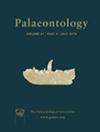地质偏见对我们早期陆地植物辐射感知的影响
IF 2.3
2区 地球科学
Q1 PALEONTOLOGY
引用次数: 1
摘要
志留纪-泥盆纪植物辐射是早期陆地生态系统进化的关键发展。描述这种辐射的多样性动态一直是众多研究的焦点。然而,人们对地质偏见对我们对这种生物多样性的看法的影响知之甚少。在这里,我们使用一个新的、全面的北美植物分布汇编,以及宏观岩性数据集,来阐明早期陆地植物的古植物学和地质记录之间的关系。结果表明,在物种和属级别上观察到的原始多样性模式与沉积岩体积的波动显著相关,尤其是非海洋含化石沉积物。埃姆西阶(早泥盆纪)之前缺乏陆地沉积矿床,因此很难准确描述北美埃姆西纪之前的植物多样性。然而,补充分析表明,采样标准化的多样性模式部分纠正了原始轨迹,特别是在属一级,如果有足够的非海洋沉积物可供采样。我们的研究结果强调,地质不完整性仍然是描述早期植物多样化的基本偏见。这表明,即使采样范围很广,观察到的多样性模式也可能反映出岩石记录的异质性,这模糊了我们对陆地植被早期历史的理解。本文章由计算机程序翻译,如有差异,请以英文原文为准。
The effect of geological biases on our perception of early land plant radiation
The Silurian–Devonian plant radiation was a critical development in the evolution of early terrestrial ecosystems. Characterizing the diversity dynamics of this radiation has been a focus of numerous studies. However, little is known about the impact of geological bias on our perception of this biodiversification. Here, we use a new, comprehensive compilation of plant occurrences from North America, together with a Macrostrat lithological dataset, to elucidate the relationships between the palaeobotanical and geological records of early land plants. Results show that observed raw diversity patterns at both species and genus rank are significantly correlated with fluctuations of sedimentary rock volume, especially of non‐marine fossiliferous deposits. The lack of terrestrial sedimentary deposits before the Emsian (Early Devonian) makes it difficult to obtain an accurate depiction of the pre‐Emsian plant diversification in North America. However, complementary analyses reveal that sampling‐standardized diversity patterns partially correct the raw trajectories, especially at the genus‐level if enough preserved non‐marine sediments are available for sampling. Our findings highlight that geological incompleteness remains a fundamental bias for describing early plant diversification. This indicates that, even when sampling is extensive, observed diversity patterns potentially reflect the heterogeneity of the rock record, which blurs our understanding of the early history of land vegetation.
求助全文
通过发布文献求助,成功后即可免费获取论文全文。
去求助
来源期刊

Palaeontology
地学-古生物学
CiteScore
5.60
自引率
3.80%
发文量
43
审稿时长
6 months
期刊介绍:
Palaeontology publishes a wide variety of papers on palaeontological topics covering:
palaeozoology
palaeobotany
systematic studies
palaeoecology
micropalaeontology
palaeobiogeography
functional morphology
stratigraphy
taxonomy
taphonomy
palaeoenvironmental reconstruction
palaeoclimate analysis and biomineralization studies.
 求助内容:
求助内容: 应助结果提醒方式:
应助结果提醒方式:


